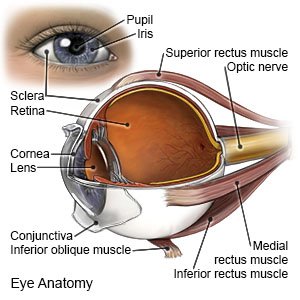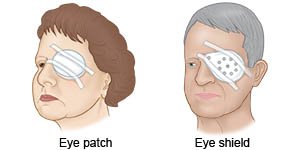Trabeculectomy
Medically reviewed by Drugs.com. Last updated on Jun 30, 2025.
A trabeculectomy is surgery to treat open angle glaucoma. The trabecular meshwork is the drainage system for your eye. A trabeculectomy will help repair the drainage system and decrease your eye pressure.
 |
WHILE YOU ARE HERE:
- Informed consent is a legal document that explains the tests, treatments, or procedures that you may need. Informed consent means you understand what will be done and can make decisions about what you want. You give your permission when you sign the consent form. You can have someone sign this form for you if you are not able to sign it. You have the right to understand your medical care in words you know. Before you sign the consent form, understand the risks and benefits of what will be done. Make sure all your questions are answered.
- An IV is a small tube placed in your vein that is used to give you medicine or liquids.
During your surgery:
- You will be given eyedrops to numb your eye. You may also be given medicine to help keep you relaxed during surgery. Your provider will use an eyelid holder to keep your eye wide open during surgery. He or she will make a tiny hole in the top of your sclera. A small piece of the sclera will be removed.
- A piece of the conjunctiva (clear layer that covers your eye) will be stitched over the hole in the sclera. When eye fluid flows out of the hole, it forms a pocket on the surface of the sclera. The hole allows enough eye fluid to flow out to keep your eye pressure at a healthy level.
- Stitches will be used to close the incisions. The stitches in your eye will dissolve on their own. Eyedrops or ointment will be put in your eye after surgery. A bandage will be taped over your eye. This keeps the area clean and dry to prevent infection. A metal or plastic shield may be placed over the bandage to prevent you from accidentally bumping your eye.

Related medications
After your surgery:
You will be taken to a room where you can rest after your surgery. Your eye doctor will check your eye pressure. You will be able to go home when your eye doctor says it is okay. You may be given medicine to help decrease inflammation, eye pressure, and help your eye heal.
RISKS:
You may get an infection or your eye may bleed. Your eye pressure may not get better and could become worse. Your vision may be worse than before the surgery. You may develop cataracts (cloudy, dark vision) after laser surgery. You could lose your vision. You may develop a scar that causes the hole to close. This could make your eye pressure increase again.
CARE AGREEMENT:
You have the right to help plan your care. Learn about your health condition and how it may be treated. Discuss treatment options with your healthcare providers to decide what care you want to receive. You always have the right to refuse treatment.© Copyright Merative 2025 Information is for End User's use only and may not be sold, redistributed or otherwise used for commercial purposes.
The above information is an educational aid only. It is not intended as medical advice for individual conditions or treatments. Talk to your doctor, nurse or pharmacist before following any medical regimen to see if it is safe and effective for you.
Further information
Always consult your healthcare provider to ensure the information displayed on this page applies to your personal circumstances.
